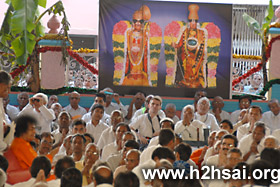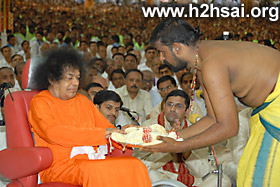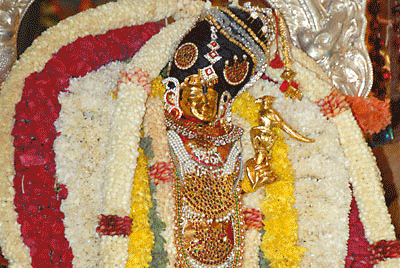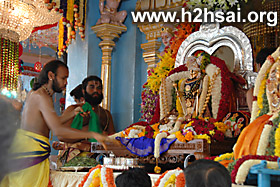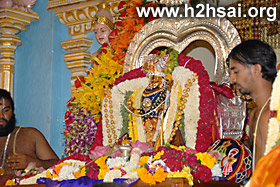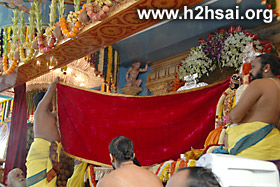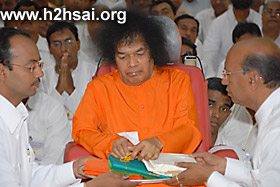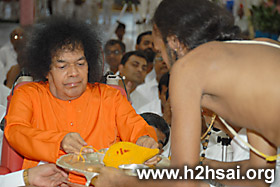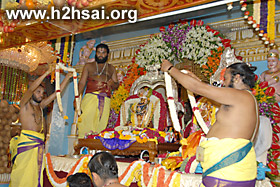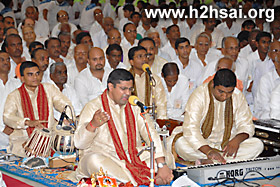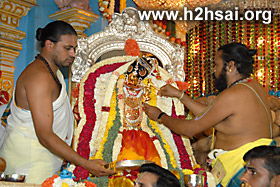September 11, 2009 – Day Three of Tiruppavai Mahotsavam and Andal Kalyanotsavam
People usually remember "black" days in history and September 11th has almost universally been considered as a "black" day or "blacklisted" day ever since the terror attack on the twin towers in USA. However we do not seem to have too many "white" days, if we can call them so, though a lot of good happens everyday the world over. Be it the newspapers, radio or television, they promise to help us see everything in black and white but one gets a feeling that somehow the black is overemphasized! A brief peep into history and a broader perspective would make one realize that it was precisely on this day 116 years ago that Swami Vivekananda thundered his first speech in Chicago and interestingly, it was a call for religious tolerance!
And again, at Prashanti Nilayam, the Andal Kalyanotsavam was scheduled. Any "Kalyanotsavam" is performed generally for the welfare (Loka kalyanam) of all, irrespective of any differences!
The morning session saw the rituals being completed with the chantings. Swami had indicated that He would be physically present to witness the holy marriage of Andal and Lord Ranganatha which in turn symbolizes the union of Prakruthi (nature) with the Purusha (God). It was shortly after 4:20 p.m. that Swami arrived for darshan. He was accorded a ceremonial welcome by the priests who were conducting the rituals.
The idols of Sri Ranganatha and Andal were being borne in palanquins that awaited Swami's arrival. Swami had a look at them when He passed through the marbled blocks.
Completing the darshan rounds, Swami moved to the stage. The sanctum was bare and the idols were to be brought in a palanquin procession.
With Swami's permission that ceremony began. The palanquin bearers moved with the gait of an elephant as they carried the "bride" and "groom" on their shoulders.
As the idols were placed on the stage, Swami moved in front and had a look at them.
He blessed the garlands made of Tulasi (basil) leaves to be placed on the idols. A welcoming aarthi was performed and soon preparations for the Kalyanam began.
After this, Swami went inside the interview room for a short while and when He returned He said that He too would witness the holy union like everyone else in the audience. Next, He himself moved down the stage and sat alongside the students and it was such a special feeling for all those around Him. Surely, the gods on the stage too would have felt very special that the Lord was taking a prime viewing position to witness them!
The Veda chanting went on ceaselessly and the chanting on stage too progressed. Swami sitting down was a unique and beautiful sight. Viewed from the ladies' side, Swami was a saffron speck on a sea of white, while viewed from the gents' side, He was a saffron speck on a colourful sea! Meanwhile on the stage, bedecking the bride with finery and anointment of the groom proceeded in the traditional and detailed manner.
Every item that was used for the worship was brought to Swami for blessings and Swami smilingly blessed them every time. As per tradition, a curtain was drawn between Andal and the Lord Ranganatha. As per Bharatiya traditions, the parents choose the partners and the bride and groom see each other for the first time only during the marriage. To ensure a joyous and sacred life, the bride and groom would see each other at a holy time (Muhurtham) till which, a curtain would be put between them.
Seeing the grandeur of the culture and the beauty of the traditions, Swami seemed very moved. He Himself blessed and gave the Mangala sutra, the sacred thread of love and goodwill worn by married women as a symbol of their marriage. In traditional style, the garlands were exchanged and the Mangala sutra tied. During this, flowers, grains and pearls were showered in plenty on the idols. Then curtains were drawn again and the idols which were separate from each other were placed on the same pedestal before the curtain was reopened.
Again customary offerings by married women to God were made as women moved to Swami from the ladies' side. Once the ceremony was complete, Swami moved to the stage and had a close look at the decked idols. At this point, all the priests too offered their salutations to Him and were blessed with little personal interactions too. Swami then sat on the dais and asked for the students to sing. He did not want any speech.
The students sang a few bhajans after which, Swami asked the people sitting right in front of Him, "You are ready to sing songs?" They vigorously nodded to say that they were eager to sing. Swami asked them to start and they began immediately. Starting with “Andal Kalayana Vaibhogame, Rangamannar Kalyana Vaibhogame …”, they continued with “Sai Easwari, Sathya Sai Easwari Jagat Palini”, “Sabkha Malik Ek Hai, Allah Malik Moula Malik ” They concluded their presentation with a Tamil song “Amma enral anbu…(Mother means Love)”.
Echoing their sentiments before the song, they said, “You are always with us mother Sai; whenever we are in trouble, you are there to protect us.” They then moved up the stage and Swami told them that He was very happy. He blessed them personally and also blessed prasadam for distribution. Prasadam was to the scale of a sumptuous dinner with chitrannam (tamarind rice), pongal (sweet rice) and sweet polis being served to all on traditional plates.
Swami told the students to begin eating and they did so, but not before chanting the Brahmaarpanam mantra in full throated manner. The priests requested Swami for a group picture and Swami gracefully obliged them. Many spoke to Him and He reciprocated their love. Aarthi was performed and by 6:30 p.m., Swami was back in Yajur Mandir.
Dear reader, how do you like this section? Does it help or inspire you in anyway? Please share your reflections with us by writing to h2h@radiosai.org mentioning your name and country.
Thank you for your time.

